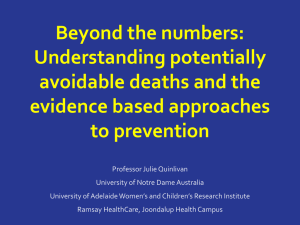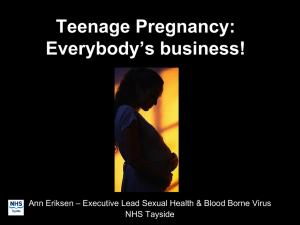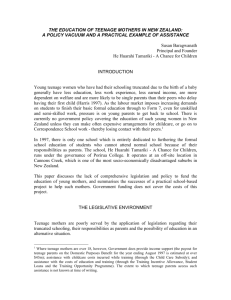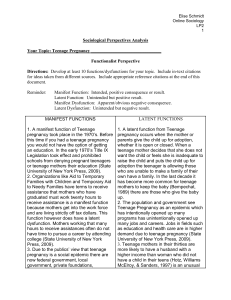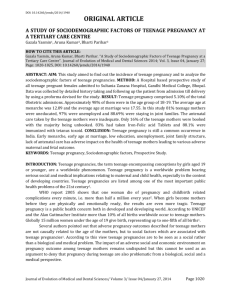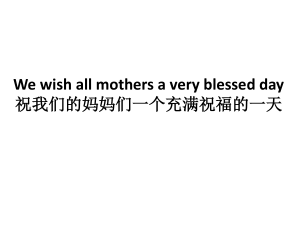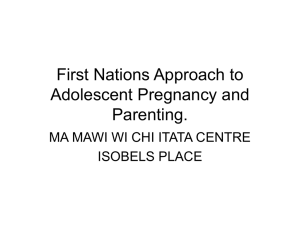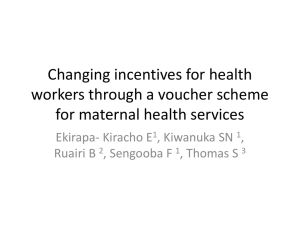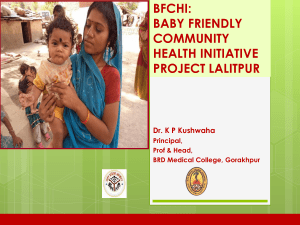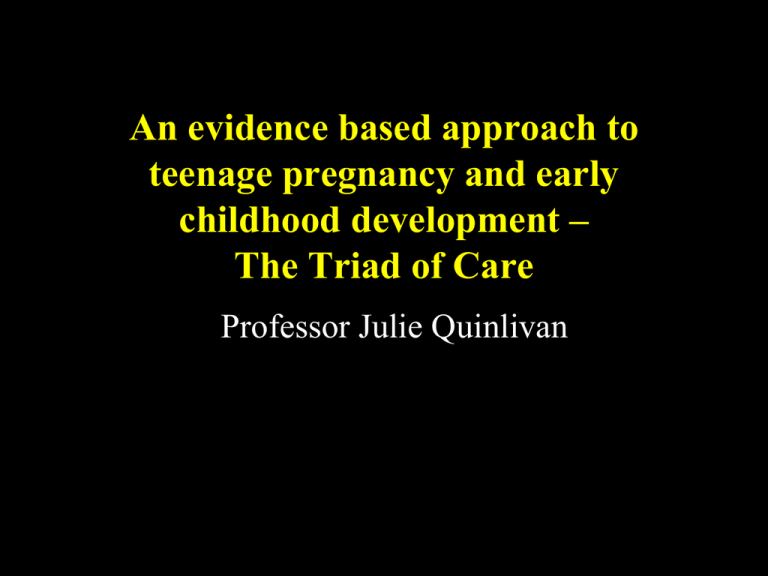
An evidence based approach to
teenage pregnancy and early
childhood development –
The Triad of Care
Professor Julie Quinlivan
The Quinlivan ‘Triad of Care’:
1. Teenage specific antenatal clinics.
2. Home visitation by nurses starting in
pregnancy and continuing until 2 years
postpartum.
3. Free childcare or peri-preschool which is
co-timed educational opportunities for teenage
parents.
The argument:
Is teenage pregnancy really
associated with adverse outcomes?
• Many studies comparing outcomes of
teenage versus nonteenage childbearing
• Multiple adverse outcomes reported
• BUT
• Were these fair comparisons?
Can you compare
middle class, married
women with solid
financial and housing
support ......
......to teenage
mothers and attribute
differences to
maternal age alone?
Socio-economic differences account for
differing outcomes – not race and not age.
More informative studies
• Control for heterogeneity by comparing economic
outcomes of sisters or of teenagers who miscarry
to those who do not.
Sister’ study
• Family background heterogeneity controlled by
using ‘within family’ estimations.
• This study compared the differences between
sisters who experienced their first pregnancy at
different ages, with one having their first birth as a
teenager
» Geronimus et al, 1992
• 3 large data sets:
– National Longitudinal Survey Young Women’s Sample
– Panel Study of Income Dynamics
– National Longitudinal Survey Youth Sample
• Found
– “the long term socio-economic differences were
minimal’
» Geronimus et al, 1992
• The authors concluded that
– ‘within-family estimates suggest that the
standard cross-sectional approaches to studying
the effects of teen childbearing on future
economic well-being overstate the costs of teen
childbearing. These estimates also suggest that
policy makers may be overly optimistic about
the ability of programs that (solely) encourage
delayed childbearing to improve the socioeconomic status of poor women and their
children”
» Geronimus et al, 1992
Another study
• National Longitudinal Survey Young Women’s Sample
• “Differences in maternal age and
–
–
–
–
–
low birthweight,
prenatal care,
smoking and alcohol use in pregnancy,
breastfeeding and
well-child visits
• Were explained by differences in family background,
NOT maternal age.
• Teenage birth may add little to already negative social
circumstances.
» Geronimus et al, 1993
But aren’t Teenage mothers are
expensive to society?
• USA study comparing teen mothers to those
who would have been teen mothers but
miscarried
• Results
“ The total expenditures on public assistance would
increase slightly’
“Moreover, the lifetime earnings of teen mothers
would decrease slightly if they delayed childbearing,
and hence, so would their contribution to the tax
base.’
Hotz et al, 1996
The economic analysis
concluded…
• “the net (of taxes) annual outlays by
government for cash-assistance and in-kind
transfers to these women would actually
increase by 35% or $4 billion. This increase
in net expenditure associated with delayed
childbearing would amount to over $1200
per teen mother.”
– Hotz et al, 1996
Most of the adverse outcomes for teen
motherhood relate to socioeconomic
environment.
These are poor unsupported women.
So how can we
help teen
mothers who
have to
overcome harsh
socio-economic
realities?
THREE
areas need
attention
The three major barriers prevent
teenage mothers from breaking the
poverty cycle:
• 1. Preterm birth and poor obstetric
outcomes
• 2. Lack of support in the form of housing,
safety and practical skills to manage a
household and new baby.
• 3. Educational limitations limiting re-entry
to the workforce
1. Preterm birth and adverse
obstetric barriers
• Preterm birth is the leading cause of
mortality and morbidity in modern obstetric
practice.
• Teenage pregnancy, particularly involving
mothers less than 18 years of age, is an
independent risk factor for preterm birth in
developed and developing nations.
Evidence based solution 1:
Implement teenage antenatal
clinics where there are 70 or
more teenagers delivering each
year.
The evidence for this…….
Large Australian cohort study
• Study Aim:
– To determine whether teenage-specific
antenatal clinics that have comprehensive
screening
policies
for
infection
and
psychosocial pathology are able to reduce the
incidence of preterm birth.
– Quinlivan et al, BJOG, 2005
Teenage clinic care
• Care provided by a multi-disciplinary team.
• Staff had guidelines for the management of
teenage pregnancy that included:
– Screening for genital tract infection, anaemia
and infections
– Social work appraisals and housing assessments
– Management plans for illegal drug use
– An open hospital admission policy
– Direct linkage to Centrelink.
Findings….
• Teenage antenatal clinics were associated
with
– Improved rates of infection and social support
screening
– When screening was performed, underlying
rates of positive findings were similar
– This suggests that problems are being missed in
teenagers delivering in general clinics
More important findings….
• Teenage antenatal clinics were associated
with
– Reductions in threatened preterm labour,
preterm premature prelabour rupture of the
membranes and actual preterm birth
Cost of teenage clinic
Unpublished data from cohort study
No teenage clinic
(N=70)
Teenage clinic
(N=70)
Cost of preterm birth
$122,000
$72,000
Cost of clinic
$0
$51,000
Total
$122,000
$123,000
Teenage specific antenatal clinics
improve outcomes for teenage
mothers and their infants.
They are also cost effective where
more than 70 teenage mothers
deliver.
2. Lack of Support
• Teenage mothers face a lack of support that
they do not anticipate whilst pregnant.
• The lack of support concerns practical
parenting and life skills tasks as well and
health issues.
• This results in stress in pregnancy and as a
new mother.
• Teenage parents will accept advice and help
from non judgemental and informed staff.
» Quinlivan et al, J Ped Adol Gynecol 2004
Evidence based solution 2:
Implement nurse home
visitation commencing in
pregnancy and continuing until
2 years of age
The evidence for this is…
Home visitation
• Meta-analyses and surveys of over
3,000 studies show that nurse home
visitation consistently provide the
most positive outcomes for vulnerable
mothers children both in the short
term and sustained over time.
– Karoly LA, Greenwood PW et al. Investing in
our children.: RAND Corporation, Santa
Monica, CA, 1998
David Old’s nurse
home visitor model
• 2 large RCTs (rural New York/Memphis, Tenn).
• Short term data: Children have fewer health
encounters, injuries or ingestions, hospitalisations,
injuries, incidences of child abuse or neglect.
• 15 year follow-up data: Adolescents less likely to
run away, be arrested, convicted, violate parole,
fewer sex partners, less smoking, alcohol, less
behavioural problems.
• Kitzman H et al, JAMA 1997; Olds D et al, JAMA 1997; Olds
D et al, JAMA 1998;Kitzman H et al, JAMA 2000
Australian RCT: Nurses
• Reduce predefined adverse outcomes:
• Neonatal death
• Nonaccidental injury
• Nonvoluntary relinquishment
• Improve knowledge of:
• Contraception
• Breast feeding
• Infant vaccination
» Quinlivan et al, Lancet, 2003
Anticipated Savings/100 Mothers
and Infants - Birth to 6 Months
Cost (A$)
$98,071
350000
300000
250000
200000
150000
100000
50000
0
Net saving
Service cost
Base cost
Control
Home visits
Nurse home visitation is an
effective intervention to
increase social support and
prevent child abuse & neglect
and improves many outcomes
for children and mothers.
It is cost effective.
3. Educational barriers
• Disengagement with schooling frequently
precedes teenage pregnancy
• Poor self esteem and poor prior achievement
levels mean teenage parents need encouragement
to return to education or workforce.
• If they can be motivated to return to education and
training then access to childcare is the key barrier.
» Quinlivan, Sexual Health, 2004; Kisker et al, 1998
3. Educational barriers
• There has been little investment on
providing time and opportunities where
teenage mothers can re-engage in schooling
• This revolves around childcare.
• However programs exist that can provide
teenage mothers with time to enable them to
return to school and can simultaneously
assist in the transition of her own child into
primary school eg: peri-preschool.
Evidence based solution 3:
Provide childcare for infants
and educational programs for
teenage parents that schedule
within
childcare hours.
The evidence for this…….
Systematic review
Parenting programs work
when participation is adequate.
• Findings of a systematic review, based upon 14
studies involving teenage mothers, found that
parenting programs can be effective in improving
a range of psychosocial and developmental
outcomes for teenage mothers and their children.
Coren E et al, J Adol 2003.
Why programs work:
The New Hope Program Example
• New Hope Program developed by local, State and
national organisations
• Implemented in two neighbourhoods in USA
• Intervention: Received
– supplemented income to above poverty level,
– provided child care and peri-preschool subsidies and
– mothers received assistance to receive employment
training and subsequent employment.
Zaslow et al. 1999
New Hope Program Example
• Assessment 2 years later
• Findings:
– found increases in employment and earnings in
intervention groups and
– positive effects on teacher-rated social competence,
behaviour problems and school performance of their
children.
Zaslow et al. 1999
Why programs don’t work:
The Teenage Parent
Demonstration Program
• US Dept of Health & Human Services program
rolled out into 4 USA States to teenage mothers.
• 2 year randomised program offered job search
training and education, workshops on life skills
and parenting, case management, transportation
and assistance to find a childcare spot but no
funding support.
• Follow up 3 to 4 years later found no benefits or
harms from the program.
Kisker et al, 1998
The Teenage Parent
Demonstration Program
• Only 30% to 50% of participants in TPD
participated in any school, work or job training in
any given month of follow-up.
• A reported lack of childcare was cited by over half
of the inactive participants as their primary barrier
to involvement.
Kisker et al, 1998
Solution:
Provide free childcare or
peri-preschool for infants and
educational programs for
teenage parents that schedule
within childcare or
peri-preschool hours.
Government scorecard for the
Teenage ‘Triad of Care’.
Item
Current status
Scorecard
Teenage-specific
antenatal clinics at all
sites where there are at
least 70 births
Five teenage specific clinics in Australia
founded on historical grounds.
No systematic evaluation of sites that
should have service provided.
D
Home visitation
Australian Nurse Family Partnership
Program being rolled out.
Needs high level of monitoring to ensure
program integrity is maintained and that
roll outs continue according to plan
B
Free childcare/peripreschool and co-timed
education interventions
for parents
No plans for this at present
E
Mean score
D+
How does the
NZ Government score?

